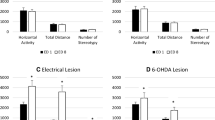Abstract
Sodium amylobarbitone, scopolamine and septal and hippocampal lesions all reduce spontaneous alternation. However, septal lesions appear to reduce alternation of places more than body turns, while the reverse is true for hippocampal lesions. The present experiments tested the effects of amylobarbitone and scopolamine on place and body turn alternation. Medial and lateral septal lesions were also tested. The former block hippocampal theta rhythm but the latter do not.
Amylobarbitone (20 mg/kg, IP) reduced alternation of body turns to chance levels when this was present in control animals, but it did not affect alternation of place. Scopolamine (1.2 mg/kg, IP) reduced both body turn alternation and place alternation. Medial septal lesions produced significant perseveration of body turns and produced a non-significant reduction in place alternation. Lateral septal lesions, tested in a small number of animals, did not appear to affect alternation.
The treatments thus reduce spontaneous alternation in differing ways which can in part be accounted for in terms of their differing effects on hippocampal theta rhythm.
Similar content being viewed by others
References
Carlton, P. L.: Brain-acetylcholine and inhibition. In: Reinforcement and behaviour, J. Tapp, ed. London: Academic Press 1969
Clody, D. E., Carlton, P. L.: Behavioural effects of lesions of the medial septum of rats. J. Comp. Physiol. Psychol. 67, 344–351 (1969)
Dalland, T.: Response and stimulus perseveration in rats with septal and dorsal hippocampal lesions. J. Comp. Physiol. Psychol. 71, 114–118 (1970)
Douglas, R. J.: Cues for spontaneous alternation. J. Comp. Physiol. Psychol. 62, 171–183 (1966)
Douglas, R. J., Isaacson, R. L.: Spontaneous alternation and scopolamine. Psychon. Sci. 4, 283–284 (1966)
Douglas, R. J., Raphelson, A. C.: Spontaneous alternation and septal lesions. J. Comp. Physiol. Psychol. 62, 320–322 (1966)
Douglas, R. J., Isaacson, R. L.: Spontaneous alternation and septal lesions. J. Comp. Physiol. Psychol. 62, 320–322 (1966)
Feldon, J., Rawlins, J. N. P.: The anatomical basis of hippocampal theta rhythm. J. Physiol. (Lond.) 284, 83 (1978)
Granjean, E., Battig, K.: Die Wirkung verschiedener Psychopharmaka auf die spontane Alternation der Ratte. Helv. Physiol. Pharm. Acta 20, 373–381 (1962)
Gray, J. A.: Drug effects on fear and frustration: possible limbic sites of action of the minor tranquillisers. In: Handbook of psychopharmacology, L. Iversen, S. Iversen, S. Snyder, eds., vol. 8. New York: Plenum Press 1977
Gray, J. A., Ball, G. G.: Frequency specific relation between hippocampal theta rhythm, behaviour and amobarbital action. Science 168, 1246–1248 (1970)
Lash, L.: Response discriminability and the hippocampus. J. Comp. Physiol. Psychol. 57, 251–256 (1964)
McNaughton, N., James, D. T. D., Stewart, J., Gray J. A., Valero, I., Drewnowski, A.: Septal driving of hippocampal theta rhythm as a function of frequency in the male rat. Neuroscience 2, 1019–1027 (1977)
McNaughton, N., Sedgwick, E. M.: Reticular stimulation and hippocampal theta rhythm in rats: effects of drugs. Neuroscience 3, 629–632 (1978)
Means, L. W., Leander, J. D., Isaacson, R. L.: The effects of hippocampectomy on alternation behaviour and response to novelty. Physiol. Behav. 6, 17–22 (1971)
O'Keefe, J., Nadel, L.: The hippocampus as a cognitive map. Oxford: Clarendon Press 1978
Singh, D.: Comparison of behavioural deficits caused by lesions in septal and ventromedial hypothalamic areas of female rats, J. Comp. Physiol. Psychol. 84, 370–379 (1973)
Stumpf, C.: Drug action on the electrical activity of the hippocampus. Int. Rev. Neurobiol. 8, 77–137 (1965)
Vanderwolf, C. H., Kramis, R., Gillespie, L. A., Bland, B. H.: Hippocampal rhythmic slow activity and neocortical lowvoltage fats activity: Relations to behaviour. In: The hippocampus, R. L. Isaacson, K. H. Pribram, eds. vol. 2, Neurophysiology and behaviour. New York, London: Plenum Press 1975
Author information
Authors and Affiliations
Rights and permissions
About this article
Cite this article
McNaughton, N., Feldon, J. Spontaneous alternation of body turns and place: Differential effects of amylobarbitone, scopolamine and septal lesions. Psychopharmacology 68, 201–206 (1980). https://doi.org/10.1007/BF00432142
Received:
Accepted:
Issue Date:
DOI: https://doi.org/10.1007/BF00432142



